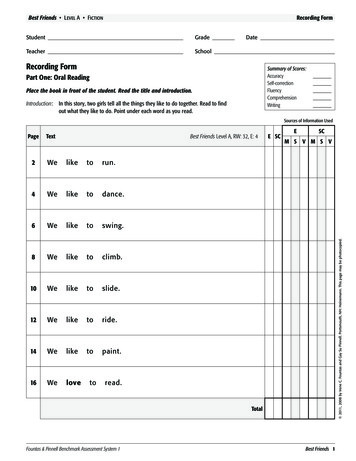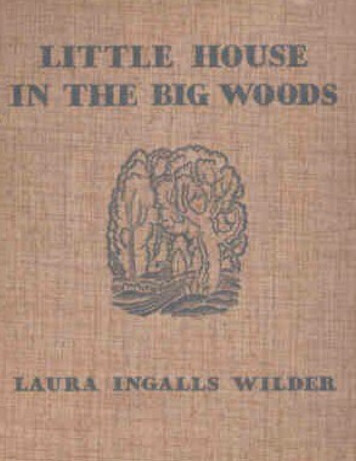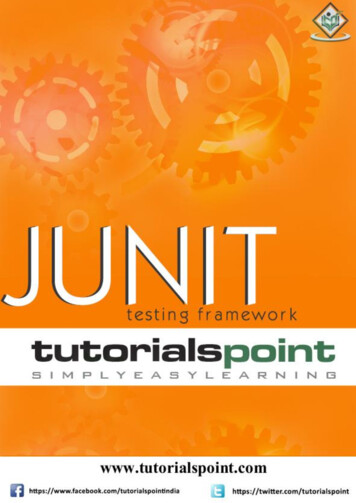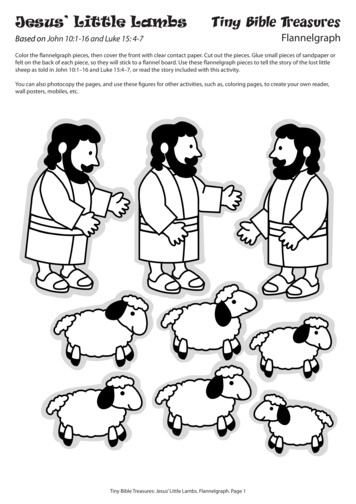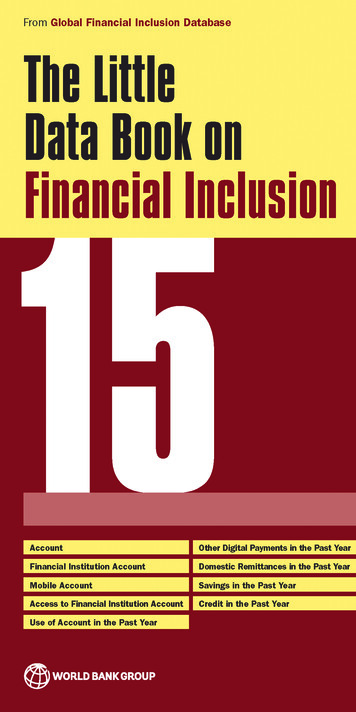
Transcription
2015THE LITTLEDATA BOOK ONFINANCIAL INCLUSION
2015 International Bank for Reconstruction and Development / The World Bank1818 H Street NW, Washington, DC 20433Telephone: 202-473-1000; Internet: www.worldbank.orgSome rights reserved1 2 3 4 18 17 16 15This work is a product of the staff of The World Bank with external contributions. The findings, interpretations, and conclusions expressed in this work do not necessarily reflect theviews of The World Bank, its Board of Executive Directors, or the governments they represent. The World Bank does not guarantee the accuracy of the data included in this work. Theboundaries, colors, denominations, and other information shown on any map in this workdo not imply any judgment on the part of The World Bank concerning the legal status of anyterritory or the endorsement or acceptance of such boundaries.Nothing herein shall constitute or be considered to be a limitation upon or waiver of theprivileges and immunities of The World Bank, all of which are specifically reserved.Rights and PermissionsThis work is available under the Creative Commons Attribution 3.0 IGO license (CC BY3.0 IGO) http://creativecommons.org/licenses/by/3.0/igo. Under the Creative CommonsAttribution license, you are free to copy, distribute, transmit, and adapt this work, includingfor commercial purposes, under the following conditions:Attribution—Please cite the work as follows: World Bank. 2015. The Little Data Book onFinancial Inclusion 2015. Washington, DC: World Bank. doi:10.1596/978-1-46480552-3. License: Creative Commons Attribution CC BY 3.0 IGOTranslations—If you create a translation of this work, please add the following disclaimeralong with the attribution: This translation was not created by The World Bank andshould not be considered an official World Bank translation. The World Bank shall notbe liable for any content or error in this translation.Adaptations—If you create an adaptation of this work, please add the following disclaimeralong with the attribution: This is an adaptation of an original work by The World Bank.Views and opinions expressed in the adaptation are the sole responsibility of the authoror authors of the adaptation and are not endorsed by The World Bank.Third-party content—The World Bank does not necessarily own each component of thecontent contained within the work. The World Bank therefore does not warrant that theuse of any third-party-owned individual component or part contained in the work willnot infringe on the rights of those third parties. The risk of claims resulting from suchinfringement rests solely with you. If you wish to re-use a component of the work, it isyour responsibility to determine whether permission is needed for that re-use and toobtain permission from the copyright owner. Examples of components can include, butare not limited to, tables, figures, or images.All queries on rights and licenses should be addressed to the Publishing andKnowledge Division, The World Bank, 1818 H Street NW, Washington, DC 20433, USA;fax: 202-522-2625; e-mail: pubrights@worldbank.org.ISBN (paper): 978-1-4648-0552-3ISBN (electronic): 978-1-4648-0553-0DOI: 10.1596/978-1-4648-0552-3Design by Communications Development Incorporated, Washington, DC.
ContentsAcknowledgments . . . . . . . . . . . . . . . . . . . . . . . . . . . . . . . . . . . . . . . . . ivForeword. . . . . . . . . . . . . . . . . . . . . . . . . . . . . . . . . . . . . . . . . . . . . . . . .vIntroduction . . . . . . . . . . . . . . . . . . . . . . . . . . . . . . . . . . . . . . . . . . . . . viiData notes . . . . . . . . . . . . . . . . . . . . . . . . . . . . . . . . . . . . . . . . . . . . . viiiRegional tables . . . . . . . . . . . . . . . . . . . . . . . . . . . . . . . . . . . . . . . . . . . 1World . . . . . . . . . . . . . . . . . . . . . . . . . . . . . . . . . . . . . . . . . . . . . . . 2East Asia and Pacific . . . . . . . . . . . . . . . . . . . . . . . . . . . . . . . . . . . . 3Europe and Central Asia. . . . . . . . . . . . . . . . . . . . . . . . . . . . . . . . . . 4High income: OECD . . . . . . . . . . . . . . . . . . . . . . . . . . . . . . . . . . . . . 5Latin America and the Caribbean . . . . . . . . . . . . . . . . . . . . . . . . . . . 6Middle East . . . . . . . . . . . . . . . . . . . . . . . . . . . . . . . . . . . . . . . . . . 7South Asia . . . . . . . . . . . . . . . . . . . . . . . . . . . . . . . . . . . . . . . . . . . 8Sub-Saharan Africa . . . . . . . . . . . . . . . . . . . . . . . . . . . . . . . . . . . . . 9Income group tables . . . . . . . . . . . . . . . . . . . . . . . . . . . . . . . . . . . . . . 10Low income. . . . . . . . . . . . . . . . . . . . . . . . . . . . . . . . . . . . . . . . . . 11Middle income. . . . . . . . . . . . . . . . . . . . . . . . . . . . . . . . . . . . . . . . 12Lower middle income . . . . . . . . . . . . . . . . . . . . . . . . . . . . . . . . . . . 13Upper middle income . . . . . . . . . . . . . . . . . . . . . . . . . . . . . . . . . . . 14Low and middle income . . . . . . . . . . . . . . . . . . . . . . . . . . . . . . . . . 15High income . . . . . . . . . . . . . . . . . . . . . . . . . . . . . . . . . . . . . . . . . 16Euro area . . . . . . . . . . . . . . . . . . . . . . . . . . . . . . . . . . . . . . . . . . . 17Country tables (in alphabetical order) . . . . . . . . . . . . . . . . . . . . . . . . . . 18Glossary. . . . . . . . . . . . . . . . . . . . . . . . . . . . . . . . . . . . . . . . . . . . . . 163Reference. . . . . . . . . . . . . . . . . . . . . . . . . . . . . . . . . . . . . . . . . . . . . 167The Little Data Book on Financial Inclusion2015iii
AcknowledgmentsThe Little Data Book on Financial Inclusion 2015 was prepared by the Financeand Private Sector Development Team of the Development Research Group,by a team led by Leora Klapper under the supervision of Asli Demirguc-Kuntand comprising Saniya Ansar, Rafael Alonso Arenas, Dorothe Singer, andPeter Van Oudheusden. The work was carried out under the managementof Kaushik Basu. The team is grateful to Douglas Randall for helping withthe questionnaire design and to Massimo Cirasino, Mario Guadamillas, JakeKendall, Douglas Pearce, Maria Soledad Martinez Peria, Peer Stein, RodgerVoorhies, and World Bank colleagues in the Development Economics VicePresidency and the Financial Markets Global Practice as well as staff atthe Bill & Melinda Gates Foundation, the Better than Cash Alliance, theConsultative Group to Assist the Poor, the GSM Association, and the Officeof the United Nations Secretary-General's Special Advocate for InclusiveFinance for Development (UNSGSA) for providing substantive comments atdifferent stages of the project. The team is also grateful for the excellentsurvey execution and related support provided by Gallup, Inc. under thedirection of Jon Clifton.The team is especially grateful to the Bill & Melinda Gates Foundation forproviding financial support making the collection and dissemination of thedata possible.Production of this volume was managed by the Development Data Group,under the direction of Haishan Fu. Substantial contributions were madeby Shelley Fu, Mohammed Omar Hadi, and William Prince, with additionalsupport provided by Azita Amjadi, Leila Rafei, Jomo Tariku, and Sup Lee.The book’s design was done by Jomo Tariku based on an original design byCommunications Development Incorporated. Typesetting was done by BartonMatheson Willse & Worthington. Staff from the World Bank's Publishing andKnowledge division oversaw publication and dissemination of the book, andAlison Strong provided editorial assistance.The reference citation for the 2014 Global Financial Inclusion (Global Findex)data provided in this book is as follows:Demirguc-Kunt, Asli, Leora Klapper, Dorothe Singer, and Peter VanOudheusden. 2015. “The Global Findex Database 2014: Measuring FinancialInclusion around the World.” Policy Research Working Paper 7255, WorldBank, Washington, DC.iv2015The Little Data Book on Financial Inclusion
ForewordBy Her Majesty Queen Máxima of the NetherlandsUN Secretary-General’s Special Advocate for Inclusive Finance for Developmentand Honorary Patron of the G20’s Global Partnership for Financial InclusionAmong those of us committed to advancing access to financial services forthe poor, the release in 2012 of the Global Financial Inclusion Database—the Global Findex—represented the beginning of a new stage in our work.Before the Global Findex, we lacked reliable information about a number ofvital questions, even the number of people we hoped to reach. Thanks tothe collective efforts that resulted in that first Global Findex, a picture offinancial inclusion emerged that transformed thinking, planning, and action.That first benchmark version provided high-quality data from 148 countriesaround the world on how adults were saving, borrowing, making payments,and managing risk.Now, three years later, I am extremely pleased that a new, second edition ofthe Global Findex Database has been released, providing us with a wealthof data that look in even more depth at where financial inclusion stands andhow far we have come. This landmark study allows policy makers, regulators,researchers, businesspeople, advocates, the development community, andothers to see what is working, what isn’t, and how we can focus our effortsmost effectively to reach the goal of universal financial inclusion.The main message embedded in the new Global Findex is tremendouslyencouraging. In a short time, financial inclusion has made great progressworldwide. The hard work being done around the globe is making a difference. Three years ago, 2.5 billion adults struggled to get by without formalfinancial services; that figure has dropped by 20 percent, to 2 billion. Thatmeans that 62 percent of adults now have an account at a financial institution or through a mobile device, up from 51 percent in 2011. This increase isbeing felt among the poorest populations in most regions, driven by mobiletechnology, digital payments, reforms that encourage correspondent banking, and relaxed customer identification.This second edition of The Little Data Book on Financial Inclusion containsa wealth of detailed information from the Global Findex Database, with lessons for public- and private-sector stakeholders working in this field. Thosecountries that have established supportive and competitive environments,policies that encourage innovation, and national financial inclusion strategies are making great strides.Thanks to the spread of mobile phones, mobile money is playing a crucialrole in extending financial services to the underserved. In Sub-SaharanAfrica, 12 percent of adults—64 million people—now use a mobile moneyaccount, helping to boost the number of financial account holders in theregion to 34 percent, up from 24 percent in 2011.Other regions are making progress in different ways. Digital banking andpayrolls paid directly into bank accounts are exploding in Latin AmericaThe Little Data Book on Financial Inclusion2015v
Forewordand savings are growing in East Asia. Digital government payments madeinto accounts for pensions or cash transfers are driving a strong increasein financial inclusion globally—more than 400 million adults are part ofsuch a system.While the mere existence of bank accounts does not result in financialinclusion, this year’s Global Findex delivers surprising and encouraging datashowing widespread, high-quality account use. More than 65 percent ofaccount users in East Asia, the Pacific, and Sub-Saharan Africa report usingtheir accounts at least three times a month to send or receive money, paybills, or save for the future.Progress has been significant, but challenges remain. So far we have notseen a closing, or even a narrowing, of the gender gap. Account ownershiphas increased for both women and men, but an 8 to 10 percentage-pointdifference persists across income groups in developing economies. We mustredouble our efforts to reach gender parity.Global Findex findings point to several promising opportunities. One hundredmillion government employees around the world are still paid in cash; moving those payment programs into digital deposits represents a relativelystraightforward step to increase financial inclusion. Strengthening marketcompetition has been shown to drive demonstrable progress, as have supportive policies that encourage innovation. The success of these approachesunderlines that governments are on the right track.Over the past decade, financial inclusion has risen as a global priority.Extending affordable, effective, and client-centric financial services, especially to low-income populations and small businesses, creates countlessopportunities—allowing individuals to put food on the table, afford betterhealth care, start a business, or save for retirement. For governments, financial inclusion lays the foundation for stability and inclusive economic growth.For the global community, financial inclusion helps accelerate economicprogress, reduce extreme poverty, and build shared prosperity.Our current understanding of financial inclusion would not have been possible without the Global Findex Database. I am proud to have been involved inthe discussions and decision making that led to the Findex, and I thank theWorld Bank Development Research Group, supported by the Bill & MelindaGates Foundation, for its vital work on this groundbreaking initiative. I encourage governments, businesses, advocates, and others to study the data inthis publication and put it to good use as we work together toward our sharedgoal of universal financial inclusion.vi2015The Little Data Book on Financial Inclusion
IntroductionThe Little Data Book on Financial Inclusion 2015 is a pocket edition of theGlobal Financial Inclusion (Global Findex) database published in 2015. Thisdata set represents a second round of data collection, following the initialround three years earlier. The database provides nationally representative,demand-side data on access to and use of accounts, credit, payments, andsavings by adults age 15 and above in 143 economies. In addition, new indicators measure people’s ability to manage risk. This book presents data forselected indicators by country, region, and income group. For some indicatorsthe data are disaggregated by age, gender, income level, and rural residence.This publication is part of the Global Findex suite of products, available bothonline and in hard copy. To learn more and to access the most recent versionof the database, visit the Financial Inclusion topic page on the World Bank’sOpen Data Platform n) orthe Global Findex web page (http://www.worldbank.org/globalfindex). Themicrodata files for each country are available in the World Bank’s MicrodataCatalog (http://microdata.worldbank.org).Launched in 2011, the Global Findex database is housed in the World Bank’sDevelopment Research Group and funded by a 10-year grant from the Bill &Melinda Gates Foundation. It is the first public global database of demandside indicators to track the financial lives of individuals over time. Coveringa range of topics, the data can be used to create a more complete pictureof how people save, borrow, manage risk, and send and receive money. Theexpanded 2014 Global Findex survey questionnaire included more nuancedquestions on the use of mobile technology to pay bills, receive wages andgovernment payments, and send money to and receive it from family livingelsewhere. The data were collected by Gallup, Inc. over the 2014 calendaryear alongside the Gallup World Poll survey. This book and the accompanying research have the potential to aid policy makers, the private sector, andthe entire global community as together we shape an effective environmentfor shared prosperity.The Little Data Book on Financial Inclusion2015vii
Data notesThe data in this book are for 2014 unless otherwise noted in the tables orthe glossary. Except for the regional grouping High income: OECD, regional aggregatesinclude data for low- and middle-income economies only. Figures in italics are for years or periods other than those specified.Symbols used:.indicates that data are not available or that aggregates cannotbe calculated because of missing data.0 or 0.0indicates zero or a value small enough that it would round to zeroat the number of decimal places displayed. indicates current U.S. dollars.Data are shown for 143 economies. The term country (used interchangeablywith economy) does not imply political independence or official recognitionby the World Bank but refers to any economy for which the authorities reportseparate social or economic statistics.viii2015The Little Data Book on Financial Inclusion
Regional tablesThe country composition of regions as used in this book is based on the WorldBank’s analytical regions and may differ from common geographic usage.East Asia and PacificCambodia, China, Indonesia, Lao People’s Democratic Republic,1Malaysia, Mongolia, Myanmar,2 Philippines, Thailand, VietnamEurope and Central AsiaAlbania, Armenia, Azerbaijan, Belarus, Bosnia and Herzegovina, Bulgaria,Georgia, Hungary, Kazakhstan, Kosovo, Kyrgyz Republic, former YugoslavRepublic of Macedonia, Moldova, Montenegro, Romania, Serbia,Tajikistan, Turkey, Turkmenistan, Ukraine, UzbekistanHigh income: OECDAustralia, Austria, Belgium, Canada, Chile, Czech Republic, Denmark,Estonia, Finland, France, Germany, Greece, Ireland, Israel, Italy, Japan,Republic of Korea, Luxembourg, Netherlands, New Zealand, Norway,2Poland, Portugal, Slovak Republic, Slovenia, Spain, Sweden, Switzerland,2United Kingdom, United StatesLatin America and the CaribbeanArgentina, Belize,2 Bolivia, Brazil, Colombia, Costa Rica, DominicanRepublic, Ecuador, El Salvador, Guatemala, Haiti, Honduras, Jamaica,Mexico, Nicaragua, Panama, Peru, República Bolivariana de VenezuelaMiddle EastDjibouti,1 Arab Republic of Egypt, Iraq, Jordan, Lebanon, West Bank andGaza, Republic of YemenSouth AsiaAfghanistan, Bangladesh, Bhutan,2 India, Nepal, Pakistan, Sri LankaSub-Saharan AfricaAngola, Benin, Botswana, Burkina Faso, Burundi, Cameroon, Chad,Comoros,1 Democratic Republic of Congo, Republic of Congo, Côted’Ivoire,2 Ethiopia,2 Gabon, Ghana, Guinea, Kenya, Lesotho,1 Liberia,1Madagascar,2 Malawi, Mali, Mauritania, Mauritius, Namibia,2 Niger,Nigeria, Rwanda, Senegal, Sierra Leone, Somalia,2 South Africa, Sudan,Swaziland,1 Tanzania, Togo, Uganda, Zambia, Zimbabwe12Included in 2011 data only.Included in 2014 data only.The Little Data Book on Financial Inclusion20151
WorldPopulation, age 15 (millions)5,231.2GNI per capita ( )10,683Account (% age 15 )All adultsWomenAdults belonging to the poorest 40%Young adults (% ages 15–24)Adults living in rural areas61.558.154.046.356.7Financial Institution Account (% age 15 )All adultsAll adults, 201160.750.6Mobile Account (% age 15 )All adults2.0Access to Financial Institution Account (% age 15 )Has debit cardHas debit card, 2011ATM is the main mode of withdrawal (% with an account)ATM is the main mode of withdrawal (% with an account), 201140.130.5.48.3Use of Account in the Past Year (% age 15 )Used an account to receive wagesUsed an account to receive government transfersUsed a financial institution account to pay utility bills17.78.216.7Other Digital Payments in the Past Year (% age 15 )Used a debit card to make paymentsUsed a credit card to make paymentsUsed the Internet to pay bills or make purchases23.215.116.6Domestic Remittances in the Past Year (% age 15 )Sent remittancesSent remittances via a financial institution (% senders)Sent remittances via a mobile phone (% senders)Sent remittances via a money transfer operator (% senders)Received remittancesReceived remittances via a financial institution (% recipients)Received remittances via a mobile phone (% recipients)Received remittances via a money transfer operator (% recipients).Savings in the Past Year (% age 15 )Saved at a financial institutionSaved at a financial institution, 2011Saved using a savings club or person outside the familySaved any moneySaved for old ageSaved for a farm or businessSaved for education or school fees27.422.6.56.523.913.822.3Credit in the Past Year (% age 15 )Borrowed from a financial institutionBorrowed from a financial institution, 2011Borrowed from family or friendsBorrowed from a private informal lenderBorrowed any moneyBorrowed for a farm or businessBorrowed for education or school feesOutstanding mortgage at a financial institution10.79.126.24.642.47.17.710.422015The Little Data Book on Financial Inclusion
East Asia & PacificPopulation, age 15 (millions)1,584.3GNI per capita ( )5,536Account (% age 15 )All adultsWomenAdults belonging to the poorest 40%Young adults (% ages 15–24)Adults living in rural areas69.067.060.960.764.5Financial Institution Account (% age 15 )All adultsAll adults, 201168.855.1Mobile Account (% age 15 )All adults0.4Access to Financial Institution Account (% age 15 )Has debit cardHas debit card, 2011ATM is the main mode of withdrawal (% with an account)ATM is the main mode of withdrawal (% with an account), 201142.934.753.337.0Use of Account in the Past Year (% age 15 )Used an account to receive wagesUsed an account to receive government transfersUsed a financial institution account to pay utility bills15.18.111.8Other Digital Payments in the Past Year (% age 15 )Used a debit card to make paymentsUsed a credit card to make paymentsUsed the Internet to pay bills or make purchases14.810.815.6Domestic Remittances in the Past Year (% age 15 )Sent remittancesSent remittances via a financial institution (% senders)Sent remittances via a mobile phone (% senders)Sent remittances via a money transfer operator (% senders)Received remittancesReceived remittances via a financial institution (% recipients)Received remittances via a mobile phone (% recipients)Received remittances via a money transfer operator (% recipients)16.636.98.718.520.629.04.915.8Savings in the Past Year (% age 15 )Saved at a financial institutionSaved at a financial institution, 2011Saved using a savings club or person outside the familySaved any moneySaved for old ageSaved for a farm or businessSaved for education or school fees36.528.56.071.036.521.330.7Credit in the Past Year (% age 15 )Borrowed from a financial institutionBorrowed from a financial institution, 2011Borrowed from family or friendsBorrowed from a private informal lenderBorrowed any moneyBorrowed for a farm or businessBorrowed for education or school feesOutstanding mortgage at a financial institution11.08.628.32.541.28.37.18.0The Little Data Book on Financial Inclusion20153
Europe & Central AsiaPopulation, age 15 (millions)211.7GNI per capita ( )7,114Account (% age 15 )All adultsWomenAdults belonging to the poorest 40%Young adults (% ages 15–24)Adults living in rural areas51.447.444.235.645.7Financial Institution Account (% age 15 )All adultsAll adults, 201151.443.3Mobile Account (% age 15 )All adults0.3Access to Financial Institution Account (% age 15 )Has debit cardHas debit card, 2011ATM is the main mode of withdrawal (% with an account)ATM is the main mode of withdrawal (% with an account), 201136.936.466.772.5Use of Account in the Past Year (% age 15 )Used an account to receive wagesUsed an account to receive government transfersUsed a financial institution account to pay utility bills22.57.312.5Other Digital Payments in the Past Year (% age 15 )Used a debit card to make paymentsUsed a credit card to make paymentsUsed the Internet to pay bills or make purchases22.914.911.9Domestic Remittances in the Past Year (% age 15 )Sent remittancesSent remittances via a financial institution (% senders)Sent remittances via a mobile phone (% senders)Sent remittances via a money transfer operator (% senders)Received remittancesReceived remittances via a financial institution (% recipients)Received remittances via a mobile phone (% recipients)Received remittances via a money transfer operator (% recipients)12.931.52.511.815.522.11.015.6Savings in the Past Year (% age 15 )Saved at a financial institutionSaved at a financial institution, 2011Saved using a savings club or person outside the familySaved any moneySaved for old ageSaved for a farm or businessSaved for education or school fees8.44.96.638.511.85.112.1Credit in the Past Year (% age 15 )Borrowed from a financial institutionBorrowed from a financial institution, 2011Borrowed from family or friendsBorrowed from a private informal lenderBorrowed any moneyBorrowed for a farm or businessBorrowed for education or school feesOutstanding mortgage at a financial institution12.47.823.62.139.52.86.210.242015The Little Data Book on Financial Inclusion
High income: OECDPopulation, age 15 (millions)877.7GNI per capita ( )44,479Account (% age 15 )All adultsWomenAdults belonging to the poorest 40%Young adults (% ages 15–24)Adults living in rural areas94.093.890.684.193.8Financial Institution Account (% age 15 )All adultsAll adults, 201194.090.0Mobile Account (% age 15 )All adults.Access to Financial Institution Account (% age 15 )Has debit cardHas debit card, 2011ATM is the main mode of withdrawal (% with an account)ATM is the main mode of withdrawal (% with an account), 201179.761.9.68.5Use of Account in the Past Year (% age 15 )Used an account to receive wagesUsed an account to receive government transfersUsed a financial institution account to pay utility bills44.317.261.1Other Digital Payments in the Past Year (% age 15 )Used a debit card to make paymentsUsed a credit card to make paymentsUsed the Internet to pay bills or make purchases65.346.754.1Domestic Remittances in the Past Year (% age 15 )Sent remittancesSent remittances via a financial institution (% senders)Sent remittances via a mobile phone (% senders)Sent remittances via a money transfer operator (% senders)Received remittancesReceived remittances via a financial institution (% recipients)Received remittances via a mobile phone (% recipients)Received remittances via a money transfer operator (% recipients).Savings in the Past Year (% age 15 )Saved at a financial institutionSaved at a financial institution, 2011Saved using a savings club or person outside the familySaved any moneySaved for old ageSaved for a farm or businessSaved for education or school fees51.645.3.70.839.79.025.0Credit in the Past Year (% age 15 )Borrowed from a financial institutionBorrowed from a financial institution, 2011Borrowed from family or friendsBorrowed from a private informal lenderBorrowed any moneyBorrowed for a farm or businessBorrowed for education or school feesOutstanding mortgage at a financial institution18.414.214.90.939.82.65.626.1The Little Data Book on Financial Inclusion20155
Latin America & CaribbeanPopulation, age 15 (millions)428.2GNI per capita ( )9,542Account (% age 15 )All adultsWomenAdults belonging to the poorest 40%Young adults (% ages 15–24)Adults living in rural areas51.448.641.237.446.0Financial Institution Account (% age 15 )All adultsAll adults, 201151.139.3Mobile Account (% age 15 )All adults1.7Access to Financial Institution Account (% age 15 )Has debit cardHas debit card, 2011ATM is the main mode of withdrawal (% with an account)ATM is the main mode of withdrawal (% with an account), 201140.428.971.157.0Use of Account in the Past Year (% age 15 )Used an account to receive wagesUsed an account to receive government transfersUsed a financial institution account to pay utility bills18.09.06.3Other Digital Payments in the Past Year (% age 15 )Used a debit card to make paymentsUsed a credit card to make paymentsUsed the Internet to pay bills or make purchases27.718.06.9Domestic Remittances in the Past Year (% age 15 )Sent remittancesSent remittances via a financial institution (% senders)Sent remittances via a mobile phone (% senders)Sent remittances via a money transfer operator (% senders)Received remittancesReceived remittances via a financial institution (% recipients)Received remittances via a mobile phone (% recipients)Received remittances via a money transfer operator (% recipients)9.5.11.334.24.328.4Savings in the Past Year (% age 15 )Saved at a financial institutionSaved at a financial institution, 2011Saved using a savings club or person outside the familySaved any moneySaved for old ageSaved for a farm or businessSaved for education or school fees13.59.67.940.610.610.617.2Credit in the Past Year (% age 15 )Borrowed from a financial institutionBorrowed from a financial institution, 2011Borrowed from family or friendsBorrowed from a private informal lenderBorrowed any moneyBorrowed for a farm or businessBorrowed for education or school feesOutstanding mortgage at a financial institution11.37.913.54.732.76.18.39.662015The Little Data Book on Financial Inclusion
Middle EastPopulation, age 15 (millions)102.0GNI per capita ( )3,894Account (% age 15 )All adultsWomenAdults belonging to the poorest 40%Young adults (% ages 15–24)Adults living in rural areas14.29.27.37.610.7Financial Institution Account (% age 15 )All adultsAll adults, 201114.010.9Mobile Account (% age 15 )All adults0.7Access to Financial Institution Account (% age 15 )Has debit cardHas debit card, 2011ATM is the main mode of withdrawal (% with an account)ATM is the main mode of withdrawal (% with an account), 20118.55.544.942.4Use of Account in the Past Year (% age 15 )Used an account to receive wagesUsed an account to receive government transfersUsed a financial institution account to pay utility bills3.30.90.2Other Digital Payments in the Past Year (% age 15 )Used a debit card to make paymentsUsed a credit card to make paymentsUsed the Internet to pay bills or make purchases3.31.52.1Domestic Remittances in the Past Year (% age 15 )Sent remittancesSent remittances via a financial institution (% senders)Sent remittances via a mobile phone (% senders)Sent remittances via a money transfer oper
Knowledge division oversaw publication and dissemination of the book, and Alison Strong provided editorial assistance. The reference citation for the 2014 Global Financial Inclusion (Global Findex) data provided in this book is as follows: Demirguc-Kunt, Asli, Leora Klapper, Dorothe Singer, and Peter Van Oudheusden. 2015.





